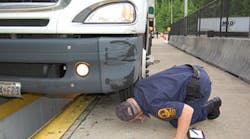Roadside inspectors use the Inspection Selection System (ISS) as a tool to help determine which vehicles will be selected for inspection. It is most commonly used at fixed weigh station sites where the station compliance readers will identify an approaching vehicle and a bypass decision is made based on a carrier’s ISS score along with the status of various credentials.
Safety is a key factor in the trucking industry, both for enforcement and the industry. But how does one measure something as complex as “safety”? After all, it is the backbone of many different aspects of the driver and carrier experience, and it impacts a variety of things including your CSA score, insurance rates, and even your ability to acquire freight.
The only way to measure safety is to assign numbers and figures to understand real-world performance. A fleet’s ISS score is one-way safety is measured, and it can also be used to prioritize the inspection of those vehicles and drivers considered to be at higher risk. Simply stated, those with lower scores have an increased opportunity to bypass a weigh station and optimize state enforcement officers’ and inspectors’ time and efforts.
A motor carrier’s safety percentile ranking in Compliance, Safety, Accountability (CSA) is a starting point for determining an ISS score. Here’s how it works: the Federal Motor Carrier Safety Administration (FMCSA) takes each motor carrier’s percentile ranking and depending on the combination of scores and the fleet’s performance in the various CSA safety categories (also known as BASICs — Behavior Analysis Safety Improvement Categories), fleets earn an ISS score from zero to 100.
Not all BASICs are given the same weight. These three BASICs have the biggest impact on an ISS score:
- Unsafe driving, which includes speeding, reckless driving, improper lane change, inattention and not wearing seatbelts
- Hours of Service Compliance, which covers failure to meet hours of service regulations including logbooks
- Crash Indicator, which considers a fleet’s history of crash involvement.
In addition to CSA data, insurance status also goes into determining the ISS score along with carrier intervention investigation results.
The goal is to have a low ISS score. A high ISS score guarantees you will be “red-lighted” and be required to pull in. The higher the score, the more likely you are to be prioritized for an inspection. Here’s how the numbers break down:
If your ISS value is between 1 and 49, it’s considered a “pass” and inspection is not warranted. The next level priority for inspections is 50-74, which is “optional” for a warranted inspection. And finally, scores between 75 and 100 are top priority, and inspection is required.
Of course, at an officer’s discretion and during a high enforcement activity period all vehicles may be pulled in, regardless of ISS score. Furthermore, to ensure compliance by the carrier, a small percentage of vehicles are randomly signaled to pull in.
Still in the majority of cases a low ISS score is a “green light.” However, even during those rare times that you are randomly selected to pull in, a low ISS score is beneficial. If two or more trucks are at the same scale, the officer may be more inclined to inspect the truck with the higher score over the one with the lower score.
A low ISS score is one way to demonstrate to law enforcement that you are serious about your fleet’s safety. More importantly, it suggests you are a safe carrier and you contribute to the overall effort to make our highways safer.



